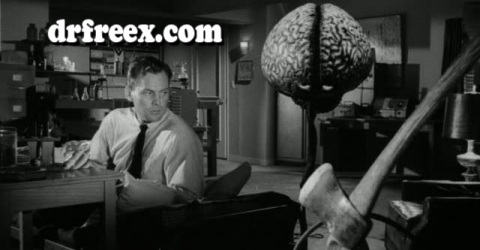 Sometimes life drops some wondrous things in your lap, sometimes just things that make you wonder. Such is the case with a couple of pieces of Asian animation that did not originate from Japan, but rather China and Taiwan.
Sometimes life drops some wondrous things in your lap, sometimes just things that make you wonder. Such is the case with a couple of pieces of Asian animation that did not originate from Japan, but rather China and Taiwan.
We’ll start with the good news – our first movie, Wan Laiming’s 1963 Da nao tian gong, titled in these parts as The Monkey King, or in this case Uproar in Heaven, is available for streaming on Amazon Video, and if you’re an Amazon Prime member, it’s free. For a Monkey King fan like myself, this is sheer catnip.
Uproar in Heaven is split into two parts of slightly under an hour each, and if you’ve seen Donnie Yen’s Monkey King, you’re already familiar with the story, though this telling approaches it from a different direction, and I’m thinking it’s somewhat closer to the classic tale. It should probably be titled The Monkey King Is Here To Kick Some Ass, because that is exactly what happens.
 The plucky Sun Wukong is definitely the hero, and the Jade Emperor, worried about his power, offers two different minor jobs in heaven to the Monkey (supposedly to more easily keep tabs on him), with disastrous results. Upset by the Royal horses being confined in stables, he sets them free. Charged with guarding the Heavenly Peach Preserves, he eats the peaches and steals the annual feast for his monkey minions (he also eats all the Jade Emperor’s Golden Elixir Pills, as one does). This Jade Emperor is nowhere near as amused by all these antics as Chow Yun Fat’s filmic version. Each time the Jade Emperor sends warriors to take Sun Wukong down a notch, with less than favorable results for the warriors.
The plucky Sun Wukong is definitely the hero, and the Jade Emperor, worried about his power, offers two different minor jobs in heaven to the Monkey (supposedly to more easily keep tabs on him), with disastrous results. Upset by the Royal horses being confined in stables, he sets them free. Charged with guarding the Heavenly Peach Preserves, he eats the peaches and steals the annual feast for his monkey minions (he also eats all the Jade Emperor’s Golden Elixir Pills, as one does). This Jade Emperor is nowhere near as amused by all these antics as Chow Yun Fat’s filmic version. Each time the Jade Emperor sends warriors to take Sun Wukong down a notch, with less than favorable results for the warriors.
 Here’s where Uproar in Heaven is truly magnificent: first, the animation is wonderful, often looking like nothing so much as a painted scroll come to life. Second of all, the fight scenes are plentiful and seem to be harvested from Peking Opera productions, complete with their distinctive music. These fight scenes are all fantastic and well-choreographed.
Here’s where Uproar in Heaven is truly magnificent: first, the animation is wonderful, often looking like nothing so much as a painted scroll come to life. Second of all, the fight scenes are plentiful and seem to be harvested from Peking Opera productions, complete with their distinctive music. These fight scenes are all fantastic and well-choreographed.
It’s also causing me to do more research into these classic Chinese characters. Above we see Sun Wukong in his fight with Nezha, another popular character we last saw in League of Gods. He got his own popular cartoon movie in 1979, Nezha Conquers the Dragon King, which is another thing to look for, grumble grumble. In the second part, Wukong takes on Erlang Shen, the chief  of the martial gods of heaven, who is more of a match for the Monkey King. Their fight segues into another setpiece from Journey of the West, Erlang and Wukong each turning into a variety of animals as they pursue each other. As I said, they are evenly matched, and it is only through the interference of another god that Wukong is captured. More disaster for heaven, though, as Wukong proves to be pretty indestructible and all attempts to execute him literally backfire.
of the martial gods of heaven, who is more of a match for the Monkey King. Their fight segues into another setpiece from Journey of the West, Erlang and Wukong each turning into a variety of animals as they pursue each other. As I said, they are evenly matched, and it is only through the interference of another god that Wukong is captured. More disaster for heaven, though, as Wukong proves to be pretty indestructible and all attempts to execute him literally backfire.
Uproar in Heaven ends with the destruction of the Heavenly Palace and Sun Wukong triumphant. No reproach and imprisonment from the Buddha yet. A happy ending, if you’re a Monkey King fan. And who isn’t?
What’s that? You don’t have Amazon Prime? You poor thing. Here:
 And then, on the other end of the scale, we have 1976’s Chinese Gods, directed by Chang Chih-hui.
And then, on the other end of the scale, we have 1976’s Chinese Gods, directed by Chang Chih-hui.
Back in the halcyon days of VHS, I would spend lots of time wading through the tapes at the late, lamented Audio-Video Plus, which had a staggering inventory, and this was one I always passed up for later, which never came. The VHS box used the very same shot from the movie as the DVD box to the right; I do not, however, recall it claiming to be “An Authentic Recreation of a True Story”. (Anyone who has seen this is so going to take issue with that statement)
So, piqued by my exuberant experience with Uproar in Heaven, I actively sought it out. High time, I figured.
Well.
I guess the first disclaimer to make is that the actual title is The Story of Chinese Gods, and it’s not Chinese, it’s Taiwanese. I would also surmise that my bewilderment at what was unspooled before me was partially due to my inebriation, but I am assured by others that this is not the case. My confused tweets of WHAT THE HELL AM I WATCHING led to some commiseration across the Network of Tubes. Chinese Gods is literally one damned thing after another, with the viewer left to his own devices as to connections and characters. Also adding to my disorientation is that the English dub is by the same voice talent that did the Shaw Brothers kung fu flicks, and I am not used to having those voices come out of cartoons.
So, having sobered up the next day, I did some research. Info is very scarce on this, but one thing was useful: this is a cartoon version of Investiture of the Gods, the same classic novel that is the basis for League of Gods. Everything that seemed familiar to my besotted brain suddenly made sense, such as the appearance of Nehza again (wearing a distracting apron – and nothing else – and voiced by a woman because he has long hair) and the eventual appearance of a caricature of the late Bruce Lee as Erlang Shen, stunt casting that actually makes some sense, even if nothing else does.
In a second watch with that knowledge, the story made much more sense. This puts me in mind of things from my youth like an animated Three Musketeers than ran on Thanksgiving afternoon on CBS after all the parades. Limited TV animation, all the sword fights were silhouettes of men waving around swords, and if you didn’t already have some familiarity with the story, you would have been lost. This is the Chinese Gods experience in a nutshell. Investiture of the Gods is now considered as much of a literary touchstone as the better-known Journey to the West, and its intended audience had some foreknowledge we Western heathens did not.
The animation style is… eclectic, to say the least. A lot of the character designs owe much to anime, but the more outlandish fantasy creatures look like fugitives from a lighthearted children’s cartoon, even if they do die bloody deaths. The fight choreography is certainly not as good as Uproar in Heaven’s, but they still obviously took more care with them. And I hope you liked the metamorphic animal pursuit from that movie, as it shows up in Chinese Gods, as well.
And here is the kicker. Chinese Gods is also available on Amazon Video, free on Prime under the title Bruce Lee and Chinese Gods. My DVD is probably sourced from that same VHS from Audio-Video Plus, damage and all. Every other domestic version I’ve seen is the same. But Amazon’s version is widescreen, as is that video clip above (and below). I cannot tell you how much easier the story is to follow when released from the constraint of fucking pan-and-scan. Also, even though it runs ten minutes shorter than my DVD version, it has scenes that are cut from the VHS version. There is even, mystifyingly, some expository text over the opening credits explaining some of the characters – if you read German. It’s a damned enigma.
So yet another reason to hate the 4:3 Satan that ruined our entertainment for so many years. I don’t think seeing this enhanced version would have caused me to start suddenly recommending Chinese Gods, but it would have made that first watch so much easier.
Then again, I freely admit that I am so jaded that when a movie actually manages to bewilder as that first viewing did, I find it refreshing and enjoyable.
Let’s close out with more Cartoon Bruce (widescreen of course) and some Street Fighter music.
Leave a comment
No comments yet.





Leave a comment